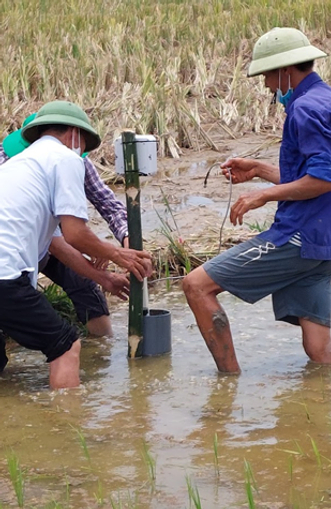Experimental pilot project of AWD (Alternate Wetting and Drying) is implemented in Nghe An province by JIRCAS (Japan International Research Center for Agricultural Science)


Equipment installed in the pilot field.
Emission of GHG (Green House Gas) from rice paddy is one of the most important issues in Vietnamese agriculture.
Agricultural activity is one of the major sources of GHG emission. In Vietnam, rice cultivation is the biggest source of methane emission in Vietnamese agriculture. Therefore, it is very important to tackle this problem for Vietnamese agriculture if the global warming is the issue.
Traditional Japanese technique of rice cultivation will reduce the GHG emission from rice paddy
AWD is the traditional technique that has been practiced over 100 years in Japan to increase yield of rice. Recently, this technique was also known to reduce methane emission form rice paddy. Methane is generated in the rice paddy soil by the micro-organism in the soil. Activity of this micro-organism become vigorous under water, therefore, drying the soil during the rice cultivation will suppress the vigor of the methane generation of this micro-organism. AWD is the technique to control the water level during rice cultivation for better growth of rice. Drying condition of soil under AWD eventually reduce the activity of the methane generating micro-organism, so the emission of GHG during rice cultivation will be reduced.
The equipment installed in the rice paddy will measure the real time water level, so the appropriate timing of irrigation and drainage can be executed from the measured data. 4 plots were prepared to measure the water level to compare the results.

Pilot plot for the experiment
JIRCAS will implement the pilot project to demonstrate the improvement in the yield so the rice farmers will utilize this technique. If more farmers utilize this AWD technique for improved yield, GHG emission will be reduced consequently. This is the objective of the pilot project to tackle the issue.